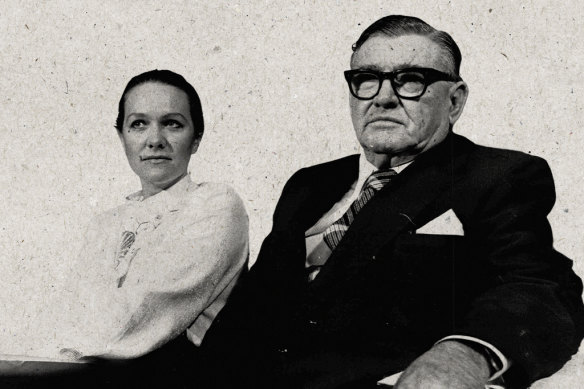'Leave me alone': Lang Hancock's final years under microscope in ...
After a four-year row over his dying wishes, a gravely ill Lang Hancock penned a letter to his daughter Gina Rinehart pleading for her to leave him alone to live the rest of his life in peace, a court has been told.

The 1989 letter, aired by lawyers for Rinehart’s eldest children Bianca Rinehart and John Hancock in the multibillion-dollar civil dispute over ownership of Hancock Prospecting’s Hope Downs iron ore mines, came after an attempt by Lang to set out assets she and her children were set to inherit.
Gina Rinehart with her father, Lang Hancock.Credit: Susan Debra Windmiller
In it, Lang told his only daughter she would gain a majority shareholding in the empire upon his death, with her children to control the trust housing his mining assets, including Hope Downs.
“Now that the dividends have started to flow, and the arrangement itself is being executed, I would appreciate it if you would leave me alone and let me live the rest of my life in peace,” he wrote.
The letter was the culmination of years of infighting over Lang’s estate, according to Bianca and John’s lawyer Christopher Withers, which became a point of contention in 1985 after he wed his housekeeper Rose Porteous.
Loading
The court was told Lang was being pressured to leave Porteous a 50 per cent share of the “big money”, but Gina was waging her own battle against it.
The row would cost Gina her role as director of the family empire, prompting threats to sue him for misappropriation of assets, excessive spending and engaging in “potentially ruinous deals” and compiling a draft petition to overthrow him.
And Gina raised concerns about mining asset transfers she now claims her father was making out of Hancock Prospecting without shareholder approval to siphon money from the company.
Withers said Lang intended to leave his four grandchildren a controlling interest in the family trust and that remained the case until a series of eleventh-hour changes to his will, including those former solicitor Carnegie Fieldhouse claimed he made in 1991 “under duress”.
“At the time of this visit in Sydney, I met with him, and he was worried, tired and exhausted,” Fieldhouse said.
“He had had enough of the pressure of Rose and simply wanted some peace.”
In the months before he died, Hancock Prospecting’s lawyer Noel Hutley, SC, said Lang confessed to unlawfully shifting assets around his company, demanded changes leaving his mining assets to Porteous be undone and reinstated Gina as a director.
Hutley insisted Hope Downs belonged to Hancock Prospecting, and the tenements were only placed in the family trust as part of the elaborate scheme Lang devised for cash.
He said Lang did that for his and Porteous’ benefit in a way that kept Hancock Prospecting shareholders, including Gina, in the dark, and she only took them back as part of his dying wish.
But Withers said that story was one she concocted. He supplied documents he said proved Gina was aware of her father’s asset shifts and that the moves she made to undo it after his death were part of a “deliberate” and “calculated scheme” designed to defraud her children.
When John Hancock quizzed her about the asset shifts she was making, Withers told the court, Gina peddled the same “false narrative” Hancock Prospecting had brought to trial.
“Gina had a standalone fiduciary obligation arising from the 1988 agreement and her children had a reasonable assumption their mother would act in their best interests,” he told the court.
“They were minors and unable to safeguard their rights themselves. There was no one in place to protect the interests of the children.
“Gina was able to divert the assets and destroy the trust and when he [Lang] died, Gina controlled the trust, Hancock Prospecting… and every other company in the group.
Withers said at the hearing he had evidence Gina knew her father intended to leave the assets to her children, pointing to a press release from 1996 during her row with Porteous in which Gina said control of the foundation was to be held for her children.
He vowed to supply documents to the court later this week which he said would show the extraordinary lengths Gina went to to shift the assets and acquire a major shareholding in the trust left for her children.
“She wanted to get those shares, and she was pressing Lang to give them to her. And she achieved it,” he said.
Gina’s daughter Bianca was again in court on Tuesday sitting in the back of the public gallery as details of her long-running stoush were aired in court after years suppressed by deeds the parties signed not to air the claims publicly.
When asked what her grandfather would make of the trial, Bianca told Nine News Perth that she missed him and “it would be great if he were here”.
The stoush has pitted Australia’s richest person against the descendants of her pioneer father’s business partner, Peter Wright, her eldest children and the company left behind by Pilbara engineer Don Rhodes.
Wright Prospecting claims it is entitled to a portion of the royalties from Hope Downs, which is home to four operational mines owned by Hancock Prospecting and Rio Tinto, under a 1980s partnership deed.
Rhodes’ family company, DFD Rhodes, insists he also played a critical role in discovering the mammoth iron ore deposit, which entitled him to a 1.25 per cent stake in its proceeds under a separate 1969 agreement.
Hancock Prospecting and its executive chair Rinehart maintain the Hope Downs assets and royalties belong to them, insisting they put in the work to recover them and invest in their development after they were confiscated by the state government.
Loading









































